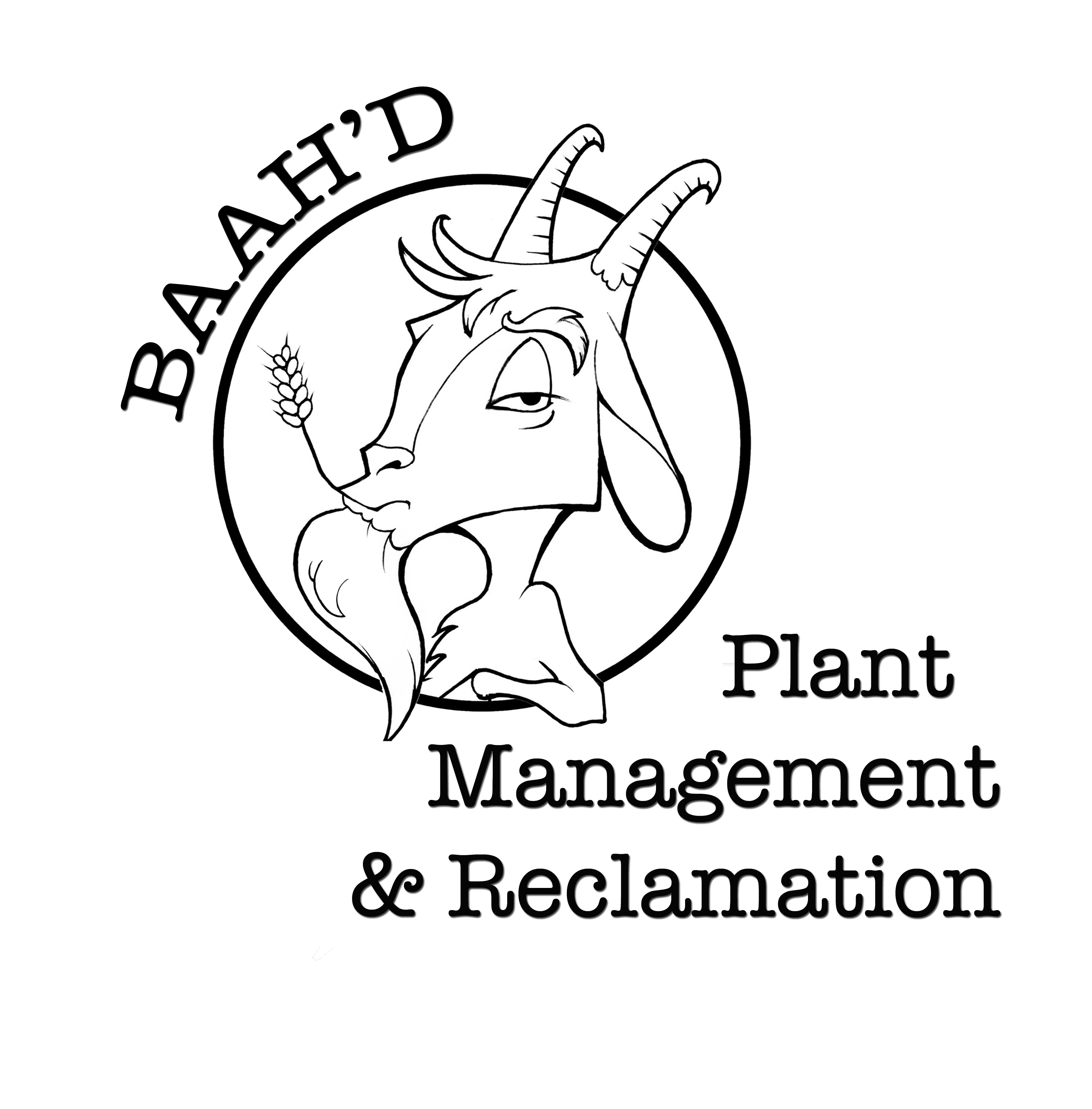The only exposure to goats the average North American has had is perhaps a few pets at a petting zoo and fabled bedtime stories. It’s not uncommon for most folks to have a difficult time envisioning the art of target browsing, when I describe a site of a few hundred goats with no fences and a few herding and guardian dogs. For most of our clients, seeing is believing, and the intensive process of target browsing is only executed by a skilled land-steward.
“The key is in how we do it, it’s a strategy that requires attention to detail and a knowledge of the livestock and land. You don’t just throw up a fence and pray, this requires good old-fashioned common-sense and hard work.”
Founder~Jeannette Hall
How Target Browsing Works
Advantages
Click for further explanation
Selectively removes vs. killing everything
Target browsing reduces kill off of preferred vegetation like native species and crops. Goats are browsers and prefer broad-leaf plants (like weeds) to grasses
unlike
sheep and cattle. Our staff
keep
the goats moving and targeted on the invasive plants.
Reduce Liabilty
Target browsing reduces liability. Target Browsing is free of toxic chemicals which can have adverse effects on; staff, landowners, neighbors, pets, livestock, wildlife, crops, wetlands, riparian areas
and
sensitive natural areas. Many toxic chemicals have been found to cause Autism, Infertility, Alzheimer’s & Cancer. Pesticides and herbicides accumulate in soils, adsorb to the soil and are often water-soluble. Toxic chemicals become more concentrated over the summer as they have a long half-life and are re-applied to plants. Toxic chemicals can migrate off-site, contaminate water and every time they are used an inherent amount of exposure and liability is assumed.
Reduced Limitations
Target browsing reduces limitations and economic loss from; human error of misidentified plants and using the wrong chemical application. Steeply sloped landscapes are no problem for goats. Goats can access invasive plants in dense brush and clear dense brush making work safer and faster for timber removal. Goats eat chemical resistant plants and because the whole plant is eaten there is no opportunity for plant mutation or a reproductive response when a dying plant uses its last reserve of energy into seed production. Goats are effective in wind, rain
and
sun.
Reduce Costs
Target browsing reduces overall duration and cost of plant management programs because target browsing promotes natural succession. While the initial treatment and eradication of invasive plants is relatively the same timeline, there is far less disturbance to the site soils and no need to amend soils. Nutrients are still available for native plants to compete with invasive weeds. Shortening the timeframe of overall site management. The costs of target browsing are significantly less than other methods. Several studies show target browsing with goats reduces weeds by 95%.
Safe for Soil & Water
Target browsing will not damage soil and you won’t need soil amendments. Countless studies show that the adsorption of herbicides interferes with the cation ion exchange in soils and causes leachates of metals and nutrients from soils which impact water and prevent nutrients from getting to other plants. Soil pH changes after 2 applications of herbicides and facilitates further weed infestations. When chemicals are used in agricultural areas and parks, where preferred vegetation is wanted, amendments must be made to the soil.
Don't Distribute Seeds
Goats stomachs are so acidic they actually destroy weed seeds and prevent seed distribution, they can also digest weeds that would otherwise be toxic to other livestock. If not timed perfectly right, mowers can actually distribute seeds and chemical spraying can trigger a reproduction response in plants, where the dying plants put their last reserve of energy into seed production and make the problem worse.
Increase Soil Nutrients
Target browsing increases soil nutrients. Goat’s digestion
break
down nutrients that are trapped in weeds and fibrous material and make it readily available for desired plants. Goat manure has a healthy N-P-K ratio and has been proven in several studies to not be a concern for smell or nutrient overloading with short application rates.
Safe in Sensitive Areas
Target browsing is safe in sensitive areas and places where sensitive receptors are
near by
like; water bodies, parks, hospitals, organic farms and markets. Goats are safe to use in riparian areas and won’t damage fragile plants and soil like cattle do. Goats do not compete with wildlife but enhance forages.
So what weeds will a goat eat?
Weeds List
Absinth
Alder
African Rue
Alkali Swainsonpea
Autum Olive
Baby’s Breath
Birch
Black Henbane
Black Meidrick
Blackberry
Bladder Campion
Blueweed
Brome Grasses
Buck Brush
Buffalo Bean
Buffalo Brush
Bull Thistle
Burdock -Common, Wooly, Lesser
Buttercup
Canary Reed Grass
Canada Thistle
Caragana
Caraway
Cheat Grass
Cinqufoil-Sulphur, Rough
Clematis
Clover -Sweet, Alsike/Dutch, Red, Purple
Common Barberry
Common Buckthorn
Common Crupina
Common Mullein
Coyote Bush
Creeping Bellflower
Current– Gooseberry, Black, Red
Dandelions
Dames Rocket
Diffuse Knapweed
Distaff Thistle
Deer Brush
Dyers Woad
European Field Pansy
Field Bindweed
Field Scabious
Fire Weed
Flowering Bullrush
Foxglove
Giant Hogweed
Giant Knottweed
Goatsbeard
Goosefoot
Gorse
Hawkweed- Yellow, Orange, Meadow, All
Hellbane
Hemp
Hoary Cress– All
Honeysuckle
Horehound
Hound’stounge
Indian Tobacco
Italian Thistl
Knapweed-All
Lambs Quarter
Larkspur
Leafy Spurge
Loco Weed
Milk thistle
Multiflora Rose
Musk Thistle
Mustard– Yellow, Garlic, Black
Nodding Thistle
Oxeye Daisy
Pale Yellow Iris
Pasture Sage
Pepper Grass
Persian Darnel
Pigweed
Pineapple Weed
Plumeless Thistle
Prairie Sage
Poison Hemlock
Poplar– Aspen, Balsam
Puncturevine
Purple Loostrife
Purple Starthistle
Queen Annes Lace
Rabbit Brush
Raspberry
Russian Knapweed
Russian Thistle
Saltcedar
Salt Lover
Scentless Chamomile
Scentless False May Weed
Scotch Thistle
Sow Thistle-Perennial, Marsh
Spotted Knapweed
Tamarisk- Chinese, Smallflower
Tansy- Common, Ragwort
Toadflax-Yellow, Dalmation
Vetch
Water Milfoil
Water Hemlock
White Cockle
Wild Rose
Willow-Wolf, Sandbar, Basket
Wormwood Sage
Yarrow
Yellow Nutsedge
Yellow Starthistle
Yucca
Don’t see something on here you want to manage, give us a call and we can always try it.
